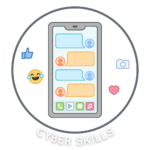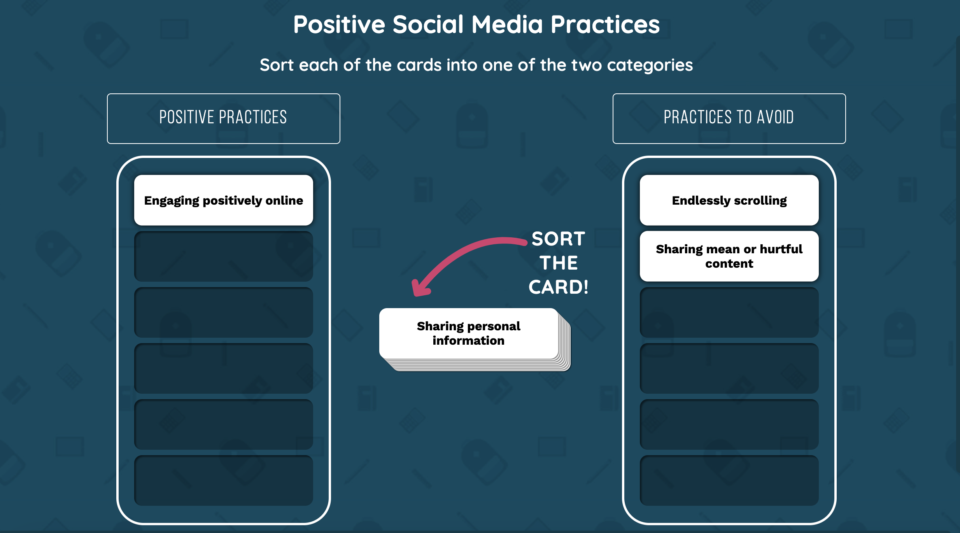
In today’s digital age, supporting positive social media use in high school is more important than ever. With the rise of online interactions, students need guidance on how to navigate the digital world responsibly. Everyday Speech’s interactive activity helps students differentiate between healthy social media habits and harmful ones. This activity, designed specifically for high schoolers, allows students to sort social media behaviors into two categories: positive practices and practices to avoid. This hands-on learning experience encourages reflection and promotes responsible online behavior.
Educators are often searching for engaging ways to teach students about cyber skills. Everyday Speech’s interactive activity is a fantastic tool for reinforcing the importance of making thoughtful decisions online. With a focus on real-world application, this activity teaches students how to engage positively on social media, avoid oversharing, and recognize harmful behaviors like endlessly scrolling or sharing hurtful content. These lessons are crucial in today’s world, where teens spend a significant amount of time online.

Supporting Positive Social Media Use in High School
First, begin by teaching students the difference between good and bad online practices. This interactive sorting activity is a fantastic way to start discussions about responsible social media use. Students will explore actions like engaging respectfully, maintaining privacy, and avoiding online conflict. With so much of their social lives happening digitally, these lessons help students develop a balanced and mindful approach to social media.
The structure of the interactive activity makes it easy for teachers to incorporate into their curriculum. Teachers can guide students through different scenarios and ask them to think critically about their actions online. What happens when someone overshares personal information? What’s the impact of spreading hurtful comments? By sorting these behaviors into categories, students actively engage with the material and reflect on their own online habits.
This lesson is part of Everyday Speech’s Cyber Skills unit, which includes video modeling lessons, interactive activities, worksheets, and visual posters. The comprehensive approach ensures that students not only learn but internalize positive online behaviors. With tools that cover topics such as maintaining privacy, online empathy, and digital citizenship, students gain a deeper understanding of how their actions online impact others.
Why Teach Positive Social Media Practices?
Social media is an integral part of high school students’ lives. While it offers many benefits, it also presents risks. Students often lack the awareness of how to use these platforms responsibly. Without guidance, they may engage in harmful behaviors, such as oversharing, cyberbullying, or succumbing to the pressures of endless scrolling. Teaching them about Supporting Positive Social Media Use in High School empowers them to make informed decisions and use social media as a tool for positive communication and connection.
Educators can also use Everyday Speech’s Cyber Skills unit to show students how to protect themselves from online dangers, such as identity theft and cyberbullying. The interactive activity is an excellent starting point for conversations about privacy settings, responsible sharing, and digital etiquette.
How to Incorporate the Activity into Your Classroom
Here’s how you can integrate the interactive activity into your daily lessons:
- Start with a Discussion: Begin by discussing students’ current social media habits. Ask questions about what they think is appropriate or inappropriate behavior online.
- Use the Interactive Activity: Introduce the activity by walking through examples of positive and negative social media practices. Encourage students to think critically about where each behavior fits and why.
- Group Work: Let students work in pairs or small groups to discuss each scenario and place the cards into the correct categories. This promotes collaboration and deeper thinking.
- Follow Up: After the activity, engage students in a reflective discussion. Ask how they can apply these lessons to their own social media use. What changes could they make to engage more positively online?
- Reinforce with Other Resources: Everyday Speech offers a range of complementary materials, including video modeling lessons and visual posters, to continue the conversation. These resources provide consistent reinforcement of the key concepts taught in the activity.
Unlock more materials for teaching Cyber Skills by signing up for your free trial today – no credit card required!
Access the full Social Communication Curriculum HERE!
Instant access to thousands of no-prep social skills activities, over 1000+ video lessons, and engaging games designed to enhance learning and development.
Conclusion
Incorporating Everyday Speech’s interactive activity into your lessons is a great way to support positive social media use in high school. By actively engaging with the material and thinking critically about their online behaviors, students will gain a better understanding of what it means to be responsible digital citizens. This activity, along with Everyday Speech’s comprehensive Cyber Skills unit, equips educators with all the resources they need to guide students toward safe and positive online habits.
Take advantage of Everyday Speech’s interactive activities, video modeling lessons, worksheets, and visual posters to ensure your students are well-prepared to navigate the digital world safely and responsibly.
Sample Video
Students learn best by watching others their same-age model the behavior! Check out a sample video modeling lesson below. We offer our entire Social-Emotional Learning platform free for 14 days here!
Related Blog Posts:
Navigating High School Challenges: Problem-Solving Techniques for Social Emotional Growth
Teaching Middle School Students to Stay Calm and Solve Problems
Promoting Mental Well-being: SEL Lessons for Middle School Students





